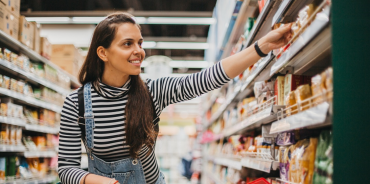Taking the Pulse of New Zealand’s grocery shoppers
Much like it has for the rest of the world, it’s been a tough couple of years for most Kiwis. In July last year, New Zealand’s rate of inflation hit 7.3% – a steeper spike than was originally anticipated, and the highest point since 1990[1]. While the situation has since begun to stabilise, prices continue to increase, albeit at a slower rate than that seen over the past few quarters. At the time of writing, inflation in the country remains high at 5.6%[2].
Against this kind of backdrop, it’s only natural that shopper behaviours would begin to change. In September 2022, for instance, dunnhumby research found that – while food prices were actually rising at around 8% – most shoppers in New Zealand believed they had increased by a staggering 22%. For retailers and brands alike, that gap between perception and reality is one that should present significant cause for concern.
A lot can happen in the space of 12 months, of course. With inflation gradually starting to ease, we were keen to know whether shoppers had seen any change in their experiences at the till. So it was that we launched the latest wave of our Consumer Pulse research – an ongoing study designed to track shopper perceptions through these unprecedented times.
With the help of supporting data from regions including South Africa, Germany, and the UK, let’s see how Kiwis are bearing up.
Price perception is still a problem – more so than anywhere else
While inflation in New Zealand might now be slowing, customers seem to be a long way from feeling that impact; 84% of the shoppers we spoke to said they believe the cost of food is much higher than it was a year ago. Even in isolation, that’s clearly a considerable number, but it also happens to be the highest of any the countries we surveyed. Only in the UK (81%) are shoppers similarly concerned about the price of groceries.
The sense that prices at the till are higher than they were a year ago manifests itself in several other areas, too. Compared with their global counterparts, New Zealanders are more likely to say that:
- Their money doesn’t go as far as it used to (76%, against a global average of 56%).
- They’re trying to buy less expensive products in response (54% against 47% global).
- They have started eating more at home (39% against 33%).
In fact, there is only one value-related issue that Kiwis are less focused on than shoppers elsewhere, and that is the amount they are spending with discount retailers. Just 16% say they’re buying more from discount banners, against a global average of 24%.
Economic concerns go beyond the grocery till, too. Two-thirds (64%) of respondents say that their own personal finances are poor, with 86% saying the same of the New Zealand economy. Even more (95%) say that they’re worried about the latter.
Good base pricing is the key to showcasing value
With New Zealand’s shoppers so acutely concerned about their grocery spend, there’s a clear need for retailers to demonstrate value wherever they can. The best way for them to do so, according to our respondents, is with low, consistent, and trustworthy pricing.
Asked which factors they take into account when judging whether a retailer provides value for money, “good” base prices on fresh products including meat, fruit, and veg was the most common response – called out by 89% of our respondents. Following that was the need for pricing to be consistent over time (87%), almost certainly a direct response to inflation, with at-shelf prices they can trust following close behind (85%).
Other issues play a role too, here. For a retailer to be seen to offer good value, the total bill needs to match shopper expectations in relation to the basket size (84%). Any price changes need to be communicated clearly and transparently (also 84%), and banners need to offer the right prices on products that are important to individual shoppers (83%) too. Clearly, just having the cheapest prices on the market isn’t enough on its own.
Inflationary “coping mechanisms” are now commonplace
As clear as they are on how retailers should deliver value, that’s not to say that New Zealanders aren’t willing to take that pursuit into their own hands. Asked about their current shopping habits, the respondents to our study pointed to several inflationary “coping mechanisms” – conscious and informed choices that help them to get more from their grocery budget.
Around half (48%) say that they usually buy the lowest-priced brand, for instance, with a similar number choosing to stock up on products when they’re on sale or special offer (45%). Private label is seen as another good way to save money (43%), and more than two-thirds say they only buy some products when they’re available at a discount (41%). Self-discipline is important, as well; 41% say that they now make a list and stick to it.
Saving money isn’t the only coping mechanism in play, however. Keen as they may be to keep costs to a minimum, around half of Kiwis (49%) say that they occasionally buy something special to treat themselves – considerably more than the global average (36%), and the highest result overall.
Value isn’t the only challenge that shoppers are facing
While pricing might be the priority for most right now, it’s not the only issue on shoppers’ minds. One of the main challenges from the peak of the pandemic – product availability – now looms large once again. Around half (49%) of New Zealand-based respondents said that it feels like more products are out-of-stock these days, second only to those from the UK (52%). Our data also suggests that women are more likely to feel this way than men.
Trust in retailers seems to be lacking, too. 44% said that they are worried that their regular grocery store doesn’t offer them the best possible prices, again the highest response globally.
Tomorrow’s priorities are health and wellbeing
In addition to gaining better insight into what shoppers are doing today, we also used this latest Consumer Pulse study to gauge their opinions about future actions. What immediately became clear when doing so is that a significant number of shoppers are focused on issues that are either directly or tangentially linked to their health and wellbeing.
Asked about their future priorities, for example, a third (30%) said that they’d be buying products from local farms and businesses. Organic (27%) and health-focused lines like vitamins (23%) were similarly popular choices. Naturally, we also see some cost-conscious activities on the list, with coupons (24%) and shopping with discounters (24%) both in people’s future plans.
It's when we look at what shoppers don’t plan to do that responses become more distinct, however. The idea of using AI to help with grocery shopping drew a strong reaction (83% saying it’s not something they’ll do), as did the thought of having meal kits (78% against) or ready-to-eat food (73%) delivered to their homes. And, while organic produce might be popular generally, 65% say they aren’t planning to buy those items from specialist stores.
Shoppers expect help to live healthily and responsibly
It’s little wonder that a large part of our audience is thinking about eating better in the future; around half (46%) say that doing so makes them feel good. The focus on local and organic produce aligns with the number who say they’re conscious about the environment (47%), too.
As important as these things are to shoppers, though, the clear message from most is that they expect retailers and brands to support them in those ambitions. More than a third (37%) claim that they would like to lead a healthier lifestyle, but find it too expensive to do so, for instance. The same is true of environmentally responsible products, which are again perceived to be too pricey for many who want to buy them (31%).
Customers may be focused on price and value at the moment, but that doesn’t mean to say that they’re not thinking about how to make the right choices too. For the brands that can support them in that endeavour, opportunity awaits.
This latest edition of the dunnhumby Consumer Pulse drew responses from more than 2,800 shoppers around the world.
[1] New Zealand inflation hits 7.3%, the highest rate since 1990 – The Guardian, 18th July 2022
[2] Annual inflation at 5.6 percent – Stats NZ Tatauranga Aotearoa, 17th October 2023
TOPICS
RELATED PRODUCTS
The latest insights from our experts around the world



